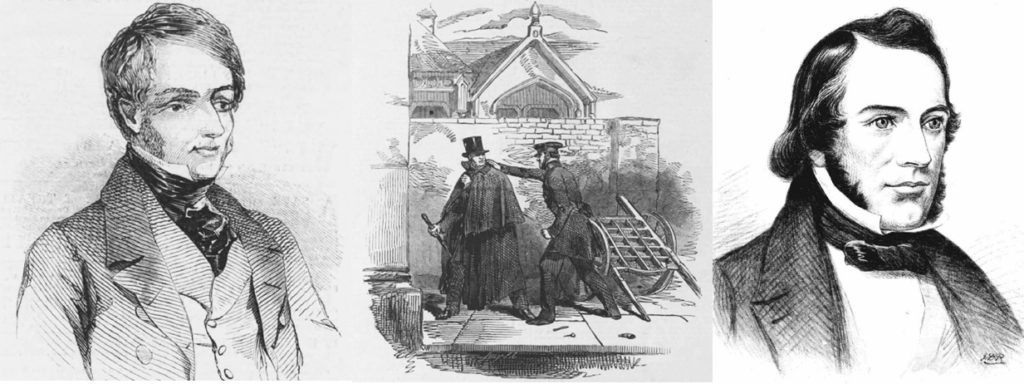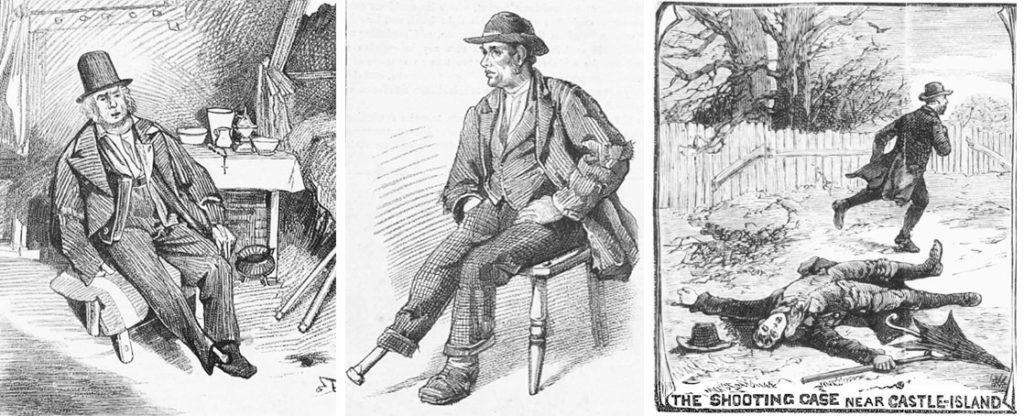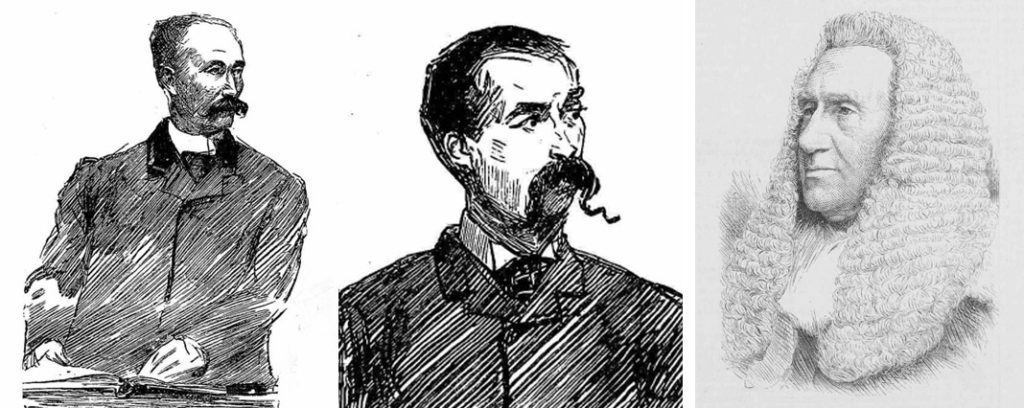Many of the artists of nineteenth century journalism remained anonymous, dubbed, nonchalantly, ‘special artist.’[1] Yet without the work of those nameless artists, a spectacular gap would be left in the record of people and events which left their mark on history.
The work of the special artist helped to alleviate the challenge faced by writers who, without the aid of imagery, had but description. Illustrations conveyed events in a way that a thousand words simply could not.
Illustrated journalism seems to have had its heyday in the nineteenth century.[2] However, the notion of graphic depiction had been around for about four hundred years.[3]

No subject was too small for the special artist, who was despatched around the world to cover the news of the day. A wonderful example of this was the first successful telegraph link between Ireland and Newfoundland in the 1860s.
Sketches of events on both sides of the Atlantic were of tremendous skill. In Ireland, the cable came in at Foilhomurrum, Valencia Island, into a field – The Telegraph Field – now owned by Castleisland man, Peter Browne.

The news of the day from Ireland, then part of the British Empire, was included in such journals as the Illustrated London News and The Graphic. Events of a political nature like the Young Ireland movement gave work to the special artist, and early sketches of William Smith O’Brien and Thomas Davis now decorate Irish history.

Distinguished men with Kerry connections also fell under the pen of the special artist.

Later in the nineteenth century, reports about landlords, tenants, agents and outrages covered much space in the news journals.

Castleisland took its fair share of the limelight. An arms find in the town in 1886 had the rare distinction of a sketch of it signed by French artist, Sir Amedee Forestier (1854-1930).

Reports of violence and shootings over land issues gave the town a dubious reputation.

The authorities who grappled with the situation, however, were also identified, courtesy of the special artist.

It was not all bad news. Traditional, sporting and cultural events formed creative subject matter for the artists.

As the century wore on, so too did the development of photography, and the services of the special artist were replaced by the photographer.

It is a tribute to the remarkable, so often unidentified, artists that modern technology is allowing us to revisit their work, enabling a face to be put to a name, or a scene to an event, with increasing success.
____________________
[1] Occasionally, illustrations bore initials or hard to decipher signatures. Further reference, The Pictorial Press Its Origin and Progress (1885) by Mason Jackson (1819-1903). George H Thomas and Mr Gilbert are mentioned in Mason Jackson’s Pictorial Press. A few names from an unquantifiable list of special artists might be noted here: Peter Cunningham (1816-1869); Mr Carmichael 1855; Robert Landells, died January 1877 aged 45, special artist of Illustrated London News ‘for many years’; Melton Prior (1845-1910); Mr Hale, his work appeared in the Illustrated London News in 1877; Richard Caton Woodville, on the staff of the Illustrated London News in 1893. A gallery of literary contributors to the Illustrated London News appeared in that paper on 14 May 1892. They included Douglas Jerrold, Shirley Brooks, Peter Cunningham, Mark Lemon, G A Sala, Joseph Hatton, Richard Garnett, Edmund Yates, John Lash Latey, Charles Mackay, John Timbs, John Latey, Howard Staunton, W B Rands, pseudonym Henry Holbeach; Albert Smith (1816-1860), Edward Miall MP, T Hall Caine, Clark Russell, Robert Buchanan, Walter Besant, Clement Scott, James Payn, Frederick Greenwood, Andrew Lang, Rev A Jessopp, Dr Andrew Wilson, J Dykes Campbell, George Meredith, H Rider Haggard, Thomas Hardy, J M Barrie, William Black. Mason Jackson died on 29 December 1903, ‘in private life one of the most courteous and attractive of personalities.’ Jackson’s older brother was wood engraver, John Jackson (1801-1848). See also ‘Thirty Years of Pictorial Journalism’ by Mason Jackson, ‘The Special Artist’ by William Simpson and ‘Three Veterans of Wood-Engraving’ by M H Spielmann, all published in Illustrated London News, 14 May 1892. [2] The following from The Pictorial Press Its Origin and Progress (1885) by Mason Jackson: The first actual attempt to illustrate the news of the day was a tract dated 1607, Woful News from Wales, or the lamentable loss of divers Villages and Parishes (by a strange and wonderful Flood) within the countye of Monmouth; which happened in January last past, 1607, whereby a great number of her Majestie’s subjects inhabiting in these parts are utterly undone. From this date tracts and pamphlets and newsletters without number are embellished with woodcuts of quaint and curious character but it is those which are concerned with murders and murderers that have the greatest vogue. These murder pamphlets begin in the seventeenth century, are immensely popular in the eighteenth, and only die out with the definite establishment of illustrated newspapers in the nineteenth century. [3] ‘Illustrated journalism may be said to have begun with Sir Francis Drake who in 1587 was the celebrity of the day’ – ‘The Beginnings of Illustrated Journalism’ Illustrated London News, 14 May 1892, a summary of Mason Jackson’s book, The Pictorial Press: Its Origin and Progress (1885). This celebrity arose from The True and Perfect Newes of the worthy and valiant exploytes performed and doone by that valiant Knight, Sir Francis Drake. [4] Images: Taking of the Castle of Artaine from The Pictorial Press: Its Origin and Progress (1885) by Mason Jackson, who reproduced it from ‘Approved, good and happy Newes from Ireland; Relating how the Castle of Artaine was taken from the Rebels, two of their Captaines kild, and one taken prisoner by the Protestants, with the arrival of 2000 foot, and 300 horse from England. Also a great skirmish between the Protestants and the Rebels at a place near Feleston, wherein the English obtained great renowne and victory: Whereunto is added a true relation of the great overthrow which the English gave the Rebels before Drogheda, sent in a letter bearing date the 27 of February to Sir Robert King, Knight, at Cecill house in the Strand. Printed by order of Parliament. London, Printed for John Wright 1641.’ Victory at Dundalk 1642 from The Pictorial Press: Its Origin and Progress (1885) by Mason Jackson. Parliament of Ladies 1644 from ‘The Beginnings of Illustrated Journalism,’ Illustrated London News, 14 May 1892, a summary of Mason Jackson’s book, The Pictorial Press: Its Origin and Progress (1885). [5] Further reference, http://www.odonohoearchive.com/glory-to-god-castleislands-link-to-the-atlantic-telegraph/ / http://www.odonohoearchive.com/fifty-two-degrees-north-calculating-castleislands-place-in-longitude-history/ / http://www.odonohoearchive.com/foilhomurrum-its-position-in-history/ [6] Illustrated London News, 29 June 1844. On 6 January 1897, a namesake, William O’Brien MP, addressed a public meeting from the balcony of the Crown Hotel, Castleisland. His speech was reported in the Kerry Sentinel, 9 January 1897. He was accompanied by Michael Joseph Flavin, MP, from North Kerry. They were welcomed by the Castleisland branch of the Irish National Federation. See also http://www.odonohoearchive.com/portraits-of-irish-nationalists-by-sir-sydney-prior-hall/ Sketch of Smith O’Brien’s arrest from the Illustrated London News, 12 August 1848. Sketch of Davis published in United Ireland, 17 September 1892. Sketch signed ‘J D R.’ [7] General Sir George De Lacy Evans published in The Graphic, 22 January 1870. From a sketch made by George Thomas for his painting of the distribution of Crimean medals then in the possession of Her Majesty the Queen. Pierce O’Mahony sketched for The Graphic, 23 October 1886. Pierce Charles de Lacy O’Mahony (1850-1930), The O’Mahony of Kerry, son of Pierce Kenefich Mahony of Kilmorna, Listowel. Sir Colomb depicted in The Graphic, 21 August 1886. The sketch appears to bear a signature by the subject’s button. Colomb genealogy in Burke’s ‘Colomb of Dromquinna and Dunkerron’. [8] Edenburn from ‘Scene of the Dynamite Outrage near Tralee, Ireland’ Illustrated London News, 6 December 1884. George Curtin depicted in The Graphic, 1 December 1888 during the Parnell Commission alongside the depictions of Maurice Leonard, JP. [9] The titles in full, which appeared in the Illustrated London News, 11 December 1886, were ‘Finding arms left on road by Moonlighters after attack on police at Castle Island’ by special artist (Forestier – Forestier started working for the Illustrated London News in 1882); ‘Rent Day at Lord Kenmare’s Office in Killarney’ and ‘Constabulary watching hay crop of tenant under notice of eviction.’ [10] ‘Boycotting in Ireland,’ The Graphic, 1 May 1886. This article, which carried illustrations of Culloty and Flynn, contained their statements on their ordeals. ‘Shooting Case near Castleisland’ from Illustrated Police News, 22 January 1887. [11] District Inspector Davis and Serjeant Gilhooly depicted during the Special Commission in 1888, The Graphic, 1 December 1888. James Whiteside from Illustrated London News, 9 December 1876. [12] ‘A St Stephen’s Day Custom: With the Wren Boys at Dingle, Co Kerry’, The Graphic, 13 January 1894. The artist initialled the illustration, ‘C J S’. ‘The Horse Fair’ appeared in the Illustrated London News, 29 December 1855. [13] Boat race from the Illustrated Sporting and Dramatic News, 20 July 1901. Image depicts Dublin University v Pennsylvania on the Lakes of Killarney. The photographs from 1911 appeared in ‘Characteristic Aspects of Irish Life’ The Graphic, 30 September 1911.


